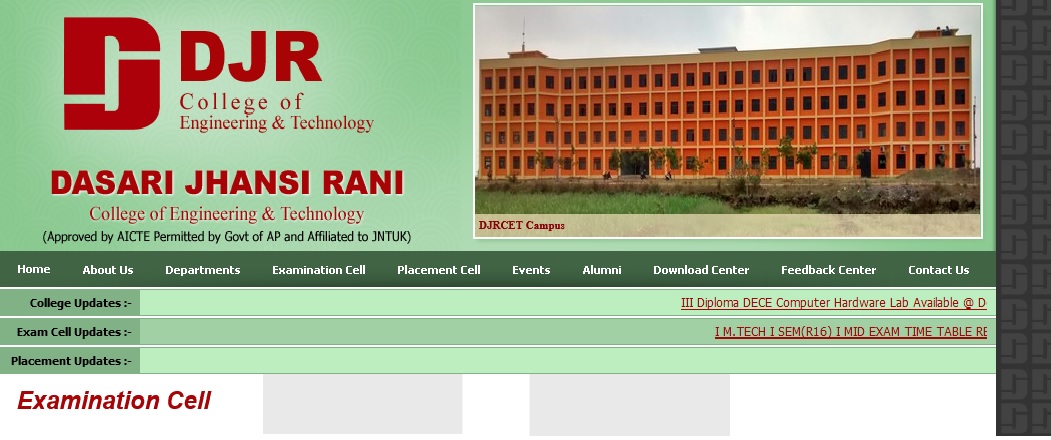RA410404 Satellite Communication B.Tech Question Paper : djriet.edu.in
Name of the College : Dasari Jhansi Rani Institute Of Engineering And Technology
University : JNTUK
Department : Electronics & Communication Engineering
Subject Code/Name : RA410404 – Satellite Communication
Year : 2008
Degree : B.Tech
Year/Sem : IV/I
Website : djriet.edu.in
Document Type : Model Question Paper
Download SATELLITE COMMUNICATION Model Question Paper : https://www.pdfquestion.in/uploads/djriet.edu.in/3009-RA410404-SATELLITE-COMMUNICATION-set1.pdf
DJRIET Satellite Communication Question Paper
IV B.Tech I Semester Regular Examinations, November 2008 :
SATELLITE COMMUNICATION :
(Electronics & Communication Engineering)
Time: 3 hours
Max Marks: 80
Answer any FIVE Questions :
Related : Dasari Jhansi Rani Institute Of Engineering And Technology RR10202 Radar Engineering B.Tech Question Paper : www.pdfquestion.in/2998.html
Set- I
All Questions carry equal marks :
1. List the various frequency bands being used in satellite communication. Compare the advantages and disadvantages of different bands considering the effects of propagation media. [16]
2. (a) The semi major and semi minor axis of an elliptical satellite orbit are 20,000km and 16000km respectively. Determine the apogee and perigee distances. [6]
(b) A satellite is moving in a near earth circular orbit at a distance of 640 km. Determine its orbital period. [4]
(c) A satellite moving in a molniya orbit having the farthest and the closest points as 35000km and 500km respectively from the earth surface. Determine the orbital time peroid and the velocity at the apogee and perigee points. [6]
3. How does the satellite maintain its orbit? With a neat block diagram explain orbit control techniques. [16]
4. Explain about the various effects and their remedies of external satellite environment around satellite antenna. [16]

5. (a) What are the various losses to be accounted into the Friis transmission equation for a practical Radio link for calculation of received power and give the altered equation suitably. [8]
(b) A satellite as a distance of 36000km. from a point on the earths surface radiates a power of 2W from an antenna with a gain of 16dBW in the direction of the observer and operates at a frequency of 11GHZ. The receiving antenna has a gain of 523dB. Find the received power. Calculate the path loss also. [8]
6. (a) Consider TDMA frame with the following parameters [8]
TDMA frame length : 16 ms TDMA burst bit rate : 43 Mbps 32 traffic bursts and 2 reference bursts CCR sequence : 256 bits UW sequence : 20 bits Order wire channel : 512 bits Management channel : 256 bits Transmit timing channel : 320 bits Service channel : 256 bits Demand assignment channel (superframe short burst only) : 1600 bits Guard time : 32 bits Voice channel bit rate : 32 bits
i. Find the frame efficiency ,
ii. Assume that the blocking probabilities at earth stations are mutually
independent andequal 0.01. Find the total network traffic intensity.
(b) A fully connected TDMA network consists of 30 earth stations. There are 400 one-way links with 0.4 erlang, and the rest have 0.2 erlang. Find the number of preassigned channels for the network required to provide a 0.01 grade of service. [8]
7. Draw the block diagram of earth station neatly and explain each block in detail. [16]
8. (a) What is LNA? Why it is required at the front-end of the receiver? Explain.[8]
(b) What is a TVRO? Explain various components of a TVRO system. [8]
Set- II
1. Write about the following
(a) Extraction of ‘G’ signal from color difference signals
(b) Formation of chrominance signals. [8+8]
2. (a) What is the range of propagation of TV signals? What are the different parameters that affect the range?
(b) Discuss briefly the requirement of booster amplifier along with merits and demerits of it. [8+8]
3. What are the different types of camera tubes used for TV and compare them in detail. [16]
4. (a) Write the principles of PAL system.
(b) Write the principles of PAL-D receiver. [6+10]
5. (a) Draw a block diagram of AGC system in monochrome television receiver and explain the functions performed by each block.
(b) Discuss briefly about sync separation and processing in monochrome television receiver. [8+8]
6. (a) With a neat sketch, explain the operation of remote control infrared transmitter.
(b) What are the merits of keyed AGC system? [10+6]
7. Draw the burst phase discreminator circuit and explain its working in color TV Receiver. [16]
8. (a) Write about Digital Terrestrial Television.
(b) Write short notes on Noise in sync pulses. [8+8]